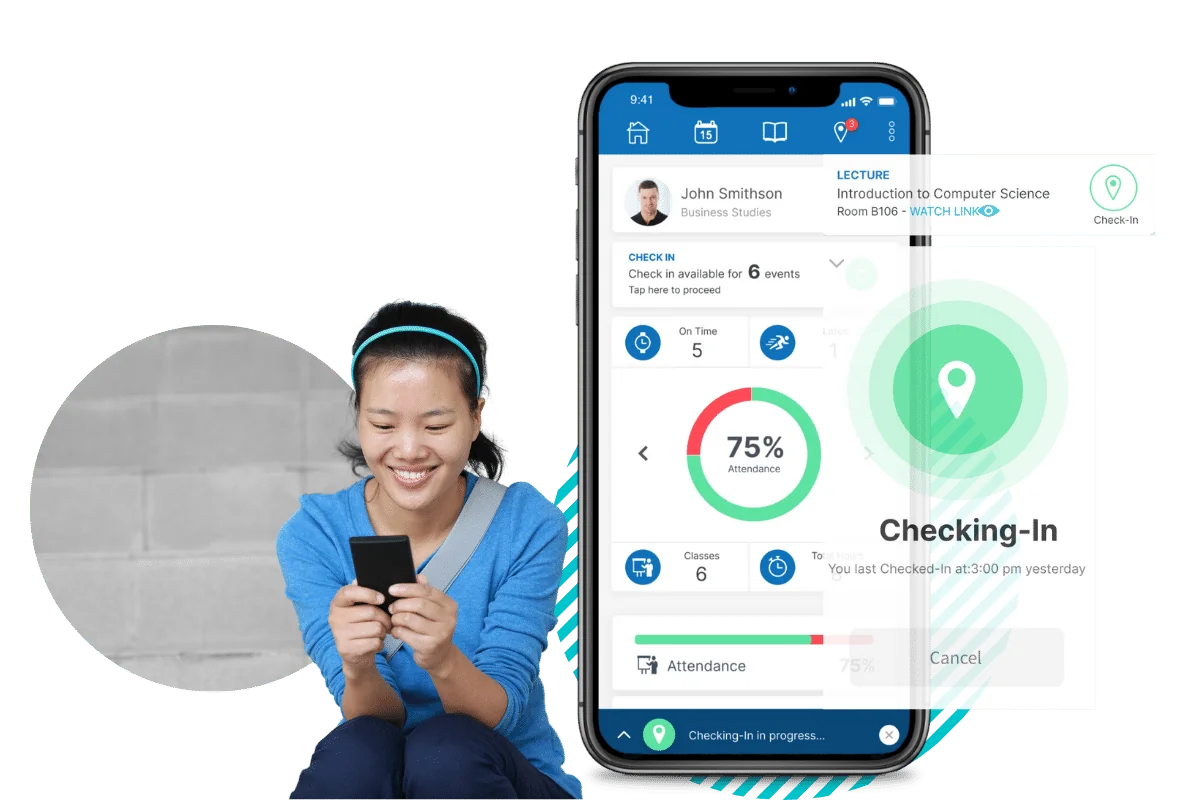Technological advances have brought with it a wide variety of options for tracking student attendance. In this article, we breakdown the 5 Most Popular Student Attendance Software Solutions
Let’s take a look at the 5 most popular student attendance software solutions:
iBeacons with Mobile App
The combination of iBeacons and a student mobile app allows students to record their own attendance, producing accurate proof of presence. By tapping-in on the SEAtS mobile app, the app confirms attendance by linking to the iBeacon in the room. Unlike other student attendance software solutions, iBeacon technology is both affordable and feature rich.
Easy to install – Each iBeacon has a battery life of 3 years, so the iBeacons can be positioned anywhere in a lecture hall without any wiring.
Data Accuracy – Each iBeacon is optimised to locate only students who are in the room which avoids fraudulent recordings. Unlike alternative options, the iBeacon can guarantee student attendance by using Bluetooth technology to connect the iBeacon with a student’s mobile app.
Affordability – iBeacons are around €50 each which makes them an extremely affordable option.
Easy to use – Once a student confirms attendance, the data is sent to the cloud which is easily accessible via a dashboard where faculty can generate reports and use workflows to receive alerts for any student who does not meet a predetermined attendance requirement like 75% attendance.
Productivity – The efficiency of student app attendance recording increases teaching time immediately, whilst also removing administration time.
Automation – Students can record attendance without a need to manually open the app.
Get in touch to discuss your student attendance management requirements!
Student Card Readers
Student attendance software solutions have been dominated by smart card readers over the last 20 years. While expensive to install, card readers allow for students to swipe as they enter a lecture hall, while also doubling as a student ID card. It should be noted that many software companies plug into existing card readers, allowing institutions to take advantage of much-improved software without having to reinvest in new hardware.
Productivity – With zero input from lecturers, class teaching time increases significantly. Negative effects on teaching time are also reduced with Late arrivals who can scan, with no interaction with the lecturer.
Ease of use – The responsive nature of a beep after a student scans makes the card reader solution a very simple option.
3rd party uses – Student ID cards can also be used to access other resources on campus like printers, and library access.
Data Accuracy – Left unmonitored, ghost attendance can occur whereby a student scans multiple cards at a time.
Affordability – Costs range from €200 up to €1500 depending on features including NFC, and Fingerprint scanning.
Installation – Card Readers need to be physically wired to the network, which in turn can be unstable if and when there is a network issue.
Queueing – While card readers have the capability to accept 60 scans a minute, in practice more than one card reader would be needed to avoid queuing which ties into affordability.
Mobile Only – GPS
GPS is a novel way of recording proof of presence by using GPS to confirm location but suffers from accuracy issues. GPS is accurate to between 5m and 20m outdoors, going up to 40m indoors. When taking into account classrooms on multiple floors, accuracy is further reduced. However, if you are only looking for a student attendance software solution which confirms attendance on campus, rather than a specific room then this is a viable option.
Automation – Once a student’s phone is connected via GPS, attendance is recorded with no direct interaction needed by the student.
Productivity – With zero input from lecturers, class teaching time increases significantly.
Affordability – GPS relies on satellites in space to send signals to smartphones, 99% of which have GPS capability. Therefore there is zero hardware required.
Data Accuracy – GPS does not work well indoors, so the resulting location is typically not accurate enough to be useful. This allows for a student to only be in a building where the classroom is to record attendance, making this a non-runner for accurate proof of presence.
GPS Switched On – If a student forgets to toggle on their phone’s GPS, their attendance will not be recorded. This means that the advantage of automated attendance recording can also be a disadvantage with inattentive students.

Mobile Only – WiFi
WiFi attendance is a unique concept for institutions looking for student attendance software solutions. If proof of presence and affordability are important factors when choosing student attendance software, then this may not be for you. Wi-Fi location-tracking works by measuring the signal strength between routers to triangulate location. The level of accuracy depends on the number of router tags in each classroom. Depending on the method deployed, accuracy can vary between 5m and 30m. Due to fluctuation in network strength, attendance data can vary wildly. Add in network maintenance which can severely impact attendance data and you have a system that brings with it as many problems as solutions.
Automation – Once a student’s phone is connected to a router, attendance is recorded with no direct interaction needed by the student
Productivity – With zero input from lecturers, class teaching time increases significantly.
Data Accuracy – Signal strength can vary depending on how many routers are in each room. Even with several routers, the signal can fluctuate which means that configuring each router needs to go beyond the classroom to guarantee a connection. Therefore, it is possible for a student to stand outside the room to record attendance making this a non-runner for accurate proof of presence.
Affordability – The number of routers dictates the level of accuracy. Routers can range in price from €120 to €300 depending on features. With a minimum of 2 or 3 routers recommended for each class, the cost can rival Card Readers.
WiFi Switched On – If a student forgets to switch on their phone’s WiFi, their attendance will not be recorded. This means that the advantage of automated attendance recording can also be a disadvantage with inattentive students.
Network Maintenance – Maintaining a campus network is challenging at the best of times. If the network goes down, attendance will not be recorded.
Mobile Only – QR Code
QR Code stands for “Quick Response” code and is mobile phone readable. A QR code is generated before each class, and students use an app to scan the code to confirm proof of presence as they enter the room. In theory, this is an excellent idea. However, in practice, it is the most rigged solution simply because the QR code can be photographed, and shared to students who are not in the classroom. There is potential to use this solution in tandem with a second system which would increase accuracy but also cost.
Affordability – No hardware is required.
Easy to use – Students open their app and scan the QR code which records attendance
Data Accuracy – The QR code can be easily copied and shared making it a poor option for accurate proof of presence.
Manual Input – The lecturer must generate the code and either present the code on a screen or email the student the code. This can take anywhere between 5 and 10mins. Students who are late will need to request the code which will also affect teaching time.
Get in touch to discuss your student attendance management requirements!
CONTACT US
If you would like to find out more about student attendance software solutions and how SEAtS can implement your preferred solution, please email sales@seatssoftware.com to get started.








